THE WORLD BIRDS - An Online Bird Book
ICTERIDAE
Grackles
Order Passeriformes Family Icteridae
ICTERIDAE
The Icterids are a group of small to medium-sized, often colorful birds, restricted to the New World. Most species have black as a predominant plumage color, often enlivened by yellow, orange or red. The majority of icterid species live in the tropics, although there are a number of temperate forms. They inhabit a range of habitats, including scrub, swamp, forest, and savannah. Temperate species are migratory. Icterids are variable in size, and often display considerable sexual dimorphism. Their size varies 15-52 cm. One unusual adaptation shared is they can open their bills strongly rather than passively, allowing them to force open gaps to obtain otherwise hidden food. Some use their gaping motion to open the skins of fruit to obtain the soft insides, and have long bills adapted to the process. Others such as cowbirds have shorter stubbier bills for crushing seeds. orioles will drink nectar. The nesting habits of these birds are similarly variable.
The Icteridae are described in the following articles: black birds, caciques, cowbirds, grackles, meadow lark, and orioles.
The Icteridae are described in the following articles: black birds, caciques, cowbirds, grackles, meadow lark, and orioles.
Grackles
Order Passeriformes Family Icteridae
New World grackles are long-tailed blackbirds. They have stout, pointed bills that can be used for cracking hard seeds as well as digging in the soil for grubs. The males are black and can appear iridescent in the sun. Females are smaller than the males and lighter in color. Asian mynas of genus Gracula are also sometimes referred to as grackles, but they are unrelated to the New World grackles.
Genus Hypopyrrhus - 1 species
Grackle,_Red-bellied Hypopyrrhus pyrohypogaster Found: Columbia
The Red-bellied Grackle has red belly, under-tail; rest black. Its closest relative may be the oriole blackbird.
Image by: 1) Andres Cuervo 2) Eveha 3) Francesco_Veronesi 4, 5) Arley_Vargas 6) _Felix_Uribe 1) Juvenile



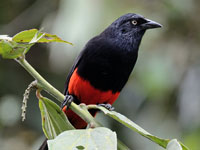


Genus Lampropsar - 1 species
Grackle,_Velvet-fronted Lampropsar tanagrinus Found: South America
The Velvet-fronted Grackle has black plumage, glossy on back; dark iris; slighlty rounded tail.
Image by: 1) Cephas 2) Sergey Pisarevskiy - Bolivia

Genus Macroagelaius
Grackle,_Columbian_Mountain also Mountain Grackle Macroagelaius subalaris Found: Columbia
The Columbian Mountain Grackle has mainly black plumage; thin chestnut shoulder stripe (hard to see).
Image by: 1) Cephas 2) Ron Knight 3) Nick Athanas 


Grackle,_Golden-tufted also Golden-turted Mountain Grackle Macroagelaius imthurni Found: Brazil, Guyana, Venezuela
The Golden-tufted Mountain Grackle has mainly black plumage; thin golden shoulder stripe..
Image by:
1) Cephas 2) Catherine Harper - Venezuela 3) Brendan_Ryan - Venezuela


Genus Quiscalus
Grackle, Boat-tailed Quiscalus major Found: North America (coastal areas from New York to Gulf Coast)
The male Boat-tailed Grackle has iridescent black plumage; long dark bill, pale yellowish or brown iris; long keel-shaped tail. Female has tawny-brown plumage with darker wings and tail.
Similar to: Brewer's Blackbird. Boat-tailed Grackle has a more massive bill.
Similar to: Common Grackle. Male and female Common Crackles resemble male Boat-tailed Grackle. Only the head of the Common Grackle is purple, while the Boat-tailed Grackle is unicolored.
Similar to: Great-tailed Grackle. Range usually distinguishes between Boat-tailed Grackles and Great-tailed Grackles. They do overlap in costal Louisiana and Texas. Great-tailed Grackle usually has a flatter head.
Image by: 1, 2, 3, 4, 5, 6, 7, 8) Dick Daniels - North Carolina Similar to: Brewer's Blackbird. Boat-tailed Grackle has a more massive bill.
Similar to: Common Grackle. Male and female Common Crackles resemble male Boat-tailed Grackle. Only the head of the Common Grackle is purple, while the Boat-tailed Grackle is unicolored.
Similar to: Great-tailed Grackle. Range usually distinguishes between Boat-tailed Grackles and Great-tailed Grackles. They do overlap in costal Louisiana and Texas. Great-tailed Grackle usually has a flatter head.
1 - 4) Female 5 - 8) Male

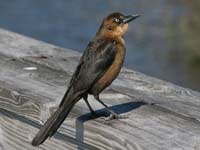






Grackle, Carib Quiscalus lugubris Found: South America
The male Carib Grackle has black plumage with an iridescent purple sheen; yellow eyes; strong dark bill. Female has dark brown upperparts; ligther brown underparts
Image by: 1) Mark Yokoyama 2) birdphotots.com - Venezuela 3, 6 Mark Stevens - Grenada 4) Taran Rampersad 5) Tom Friedel (BirdPhotos.com) - Venezuela 1) Juvenile 2 - 4) Female 5, 6) Male



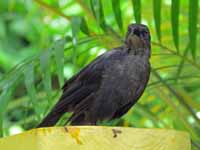


Grackle, Common Quiscalus quiscula Found: North America
The Common Grackle has dark plumage with iridecence on the head and shoulders; bronze wings, tail. Female is smaller, has a proportionally shorter tail; less iridesence.
Similar to: Brewer's Blackbird. Common Grackle has a more massive bill.
Similar to: Boat-tailed Grackle, Great-tailed Grackle. Male and female Common Crackles resemble male Boat-tailed Grackle and male Great Tailed Grackle. Only the head of the Common Grackle is purple, while the other 2 species are unicolored.
Image by: 1) Vitaliy Khustochka - New York 2) Kate Hannon - Massachuetts 3) Mark Watson - New Mexico 4) Pat Gaines 5) Charity Drake 6) Dick Daniels - New York 7, 8) Dick - North Carolina Similar to: Brewer's Blackbird. Common Grackle has a more massive bill.
Similar to: Boat-tailed Grackle, Great-tailed Grackle. Male and female Common Crackles resemble male Boat-tailed Grackle and male Great Tailed Grackle. Only the head of the Common Grackle is purple, while the other 2 species are unicolored.
1) Juvenile 2. 3) Female 5 - 8) Male








Grackle, Great-tailed Quiscalus mexicanus Found: southwest USA to South America
The male Great-railed Grackle has black plumage with an iridescnt violet-blue shean; very long tail. Female has mainly brownish-black plumage; pale brown underparts.
Similar to: Boat-tailed Grackle. Range usually distinguishes between Boat-tailed Grackles and Great-tailed Grackles. They do overlap in costal Louisiana and Texas. Great-tailed Grackle usually has a flatter head.
Similar to: Brewer's Blackbird. Great-tailed Grackle has a more massive bill.
Similar to: Common Grackle. Male and female Common Crackles resemble male Great-tailed Grackle. Only the head of the Common Grackle is purple, while the Great-tailed Grackle is unicolored.
Image by: 1, 6, 7, 8) Dick Daniels - Arizona 2, 3, 4, 5, 9, 10) Dick - Panama Similar to: Boat-tailed Grackle. Range usually distinguishes between Boat-tailed Grackles and Great-tailed Grackles. They do overlap in costal Louisiana and Texas. Great-tailed Grackle usually has a flatter head.
Similar to: Brewer's Blackbird. Great-tailed Grackle has a more massive bill.
Similar to: Common Grackle. Male and female Common Crackles resemble male Great-tailed Grackle. Only the head of the Common Grackle is purple, while the Great-tailed Grackle is unicolored.
1) Juvenile 2 - 5) Female 6 - 10) Male


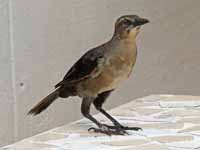



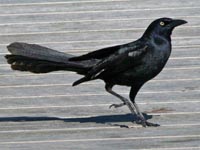



Grackle, Greater Antillean Quiscalus niger Found: The Caribbean
The male Greater Antillean Grackle has glossy black plumage with a large tail. Female is similar, but less glossy and has a smaller tail.
Image by: 1, 2, 4, 5, 6, 7) Dick Daniels - Puerto Rico 3) Dick - Jamaica1 - 5) Female 6, 7) Male 2) Bird landing on a metal roof and then slipping off!







Grackle,_Nicaraguan Quiscalus nicaraguensis Found: Nicaragua
The male Nicaraguan Grackle has iridescent glossy black plumage; pale yellow eye. The gloss is violet on the belly and tail, violet-green on the head, back and breast and blue-green on most of the wing. The tail of the male is V-shaped, rising from the centre to the outer feathers. Female has dark brown upperparts; lighter underparts.
Image by: 1)
Dick Culbert 2) Sergio_Quesada Kryssia2, 3) Female 4) Male



